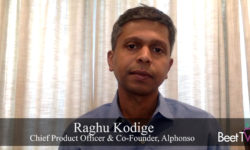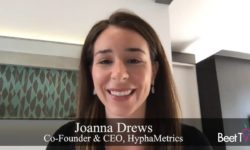DENVER – It has long been a medium used to fill the top of the marketing funnel, awareness.
But, bit by bit, the connection of TV to the internet is upgrading the old box in the corner of the living room with new tricks.
The new ability of TV to not just deliver messages but to help track, measure and trace those messages’ consequential impact is helping TV become more of a performance or direct-response medium.
In this video interview with Beet.TV, Stephanie Geno, marketing SVP at Innovid, a software vendor helping the transition, explains.
New tricks for the old dog
“What we’ve seen as of late is that that shift has accelerated even faster than we could have imagined,” Geno says. “With that shift, brands are trying to understand, ‘What can I do with TV now that I couldn’t before?’
“They’re starting to really embrace a lot of the functionality that has been typically reserved for digital – addressability, interactivity, dynamic content – and leveraging that to think about, ‘How do I leverage TV beyond just a big brand awareness spot?’
“We’re starting to see a lot of QR codes getting incorporated into ads where you can look at something and say, ‘That’s interesting, I want to learn more.’
Geno says more brands are also leveraging SMS codes in TV ads, prompting viewers to text in to receive discount coupons.
Such functionality all helps “close the loop” between the TV ad play-out and actions taken on brand websites or retail establishments.
Questions arise
These new super-powers could boost ads’ return on investment, Geno says.
But they also pose new questions, like:
- how can advertisers measure and understand the impact of TVs’ new direct engagement opportunities?
- what is the optimum ad presentation for generating that engagement?
- how can advertisers produce the creative that has to flex across channels and incorporate interactivity?
Geno says the emerging measurement challenge today demands “progress, not perfection”, while Innovid says it is trying to ensure creative agencies can use their existing tools, including those from Adobe, rather than to learn new software to make the best of interactive TV.
For optimized, personalized
An element which may hold the key to heightened engagement could be personalization.
Innovid in July released the findings of a report it commissioned to understand viewers’ sentiments on personalized advertising.
New Study: Consumers want to be seen, understood, and shown advertising that matches their mindset in the moment and beyond. View the full infographic: https://t.co/pSc8oOty0g #advertising #consumerstudy #personalization pic.twitter.com/uD7EGfVX5h
— Innovid (@innovid) July 15, 2020
Amongst the findings:
- 43% of respondents said it was important that the online ads they see are personalized, incorporating geography, interests and behaviors.
- Nearly 30% (29%) said they would be more likely to buy something if an ad was personalized.
- Personalization also influenced loyalty, with 31% saying they tend to be more loyal to brands that embrace personalized ads.
Viewers said they wanted ads that understand the context of a given moment, including for events, product offers or community information.














































